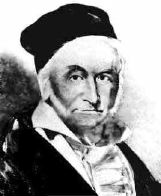

At the age of 7, Carl Friedrich Gauss started elementary school, and his potential was noticed almost immediately. His teacher was amazed when Gauss summed the integers from 1 to 100 instantly by spotting that the sum was 50 pairs of numbers, each pair summing to 101.
In 1788, Gauss began his education at the Gymnasium, where he learnt High German and Latin. Gauss entered Brunswick Collegium Carolinum in 1792. At the academy Gauss independently discovered Bode's law, the binomial theorem and the arithmetic-geometric mean, as well as the law of quadratic reciprocity and the prime number theorem.
In 1795 Gauss left Brunswick to study at Göttingen University.
Gauss left there in 1798 without a diploma, but by this time he had made one of his most important discoveries - the construction of a regular 17-gon by
ruler and compass. This was the most major advance in this field since the time of Greek mathematics. Gauss returned to Brunswick where he received a degree in 1799. Gauss's dissertation was the fundamental theorem of algebra.
With a stipend from the Duke of Brunswick to support him, Gauss did not need to find a job so devoted himself to research. He published the number theory book Disquisitiones Arithmeticae in 1801.
Also in 1801, he used "least squares" to predict the orbit of Ceres, the recently discovered asteroid. In 1807 Gauss left Brunswick to take up the position of director of the Göttingen observatory. Despite losing his father, his wife, and his child in quick succession, Gauss's work never seemed to suffer from his personal tragedy. He published his second book in 1809, a major two volume treatise on the motion of celestial bodies. In the first volume he discussed differential equations, conic sections and elliptic orbits. In the second volume, the main part of the work, he showed how to estimate and then to refine the estimation of a planet's orbit. Gauss's contributions to theoretical astronomy stopped after 1817, although he went on making observations until the age of 70.
Much of Gauss's time was spent on a new observatory, completed in 1816, but he still found the time to work on other subjects. His publications during this time
include a rigorous treatment of series and an introduction of the hypergeometric function, a practical essay on approximate integration, a discussion of statistical estimators, and a work concerned with potential theory.
Gauss carried out a geodesic survey of the state of Hanover, using his extraordinary mental capacity for calculations. He regularly wrote to Schumacher, Olbers, Bessel, and Sophie Germain, reporting on his progress and discussing problems.
Because of the survey, Gauss invented the heliotrope which worked by reflecting the Sun's rays using a design of mirrors and a small telescope.
In 1822 Gauss won the Copenhagen University Prize. He published papers on the least squares method in 1823 and 1828. From the early 1800's, Gauss had an interest in the question of the possible existence of a non-Euclidean geometry. He believed in the existence of non-Euclidean geometry, although he confided in Schumacher, telling him that he believed his reputation would suffer if he admitted this in public.
Gauss had a major interest in differential geometry, and published many papers on the subject, including one with the famous theorem: "If an area in R3 can be mapped isometrically into another area of R3, the values of the Gaussian curvatures are identical in corresponding points."
Gauss had worked on physics before 1831, publishing on the principle of
least constraint, and forces of attraction. These papers were based on
Gauss's potential theory, which proved of great importance in his work on physics. He later came to believe his potential theory and his method of least squares
provided vital links between science and nature.
In 1832, Gauss and Weber began investigating the theory of terrestrial magnetism. Gauss was excited by this prospect and by 1840 he had written three important papers on the
subject. Dirichlet's principle was mentioned without proof. Gauss used the Laplace equation to aid him with his calculations, and ended up specifying a location for the magnetic South pole.
Gauss and Weber achieved much in their six years together. They discovered Kirchhoff's laws, as well as building a primitive telegraph device which could send
messages over a distance of 5000 ft. However, this was just an enjoyable pastime for Gauss. In 1837, Weber was forced to leave Göttingen when he became involved in a political dispute and, from this time, Gauss's activity gradually decreased.
Gauss spent the years from 1845 to 1851 updating the Göttingen University widow's fund. This work gave him practical experience in financial matters, and he
went on to make his fortune through shrewd investments in bonds issued by private companies.
Two of Gauss's last doctoral students were Moritz Cantor and Dedekind.
From 1850 onwards, Gauss's work was again of nearly all of a practical nature although he did approve Riemann's doctoral thesis. His health deteriorated slowly, and Gauss died in his sleep.